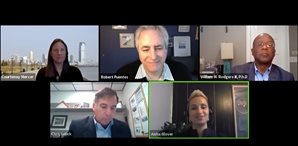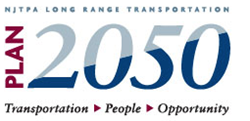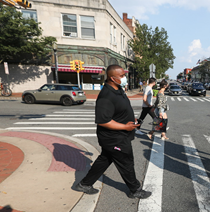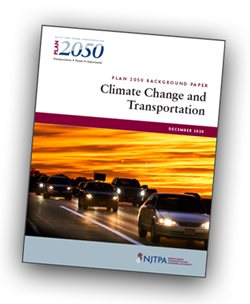January 2021
Posted: 1/27/2021 4:48:08 PM
 Transportation is an “essential building block of the American economy,” Robert Puentes, CEO and President of the Eno Center Transportation, said during his keynote speech at the NJTPA’s recent symposium, Creating Opportunity Through Transportation. The symposium was part of the NJTPA’s ongoing outreach for Plan 2050: Transportation, People, Opportunity.
Transportation is an “essential building block of the American economy,” Robert Puentes, CEO and President of the Eno Center Transportation, said during his keynote speech at the NJTPA’s recent symposium, Creating Opportunity Through Transportation. The symposium was part of the NJTPA’s ongoing outreach for Plan 2050: Transportation, People, Opportunity.
“Transportation enables global trade, empowers businesses, connects workers to their jobs, creates opportunities for struggling communities, and it provides America an opportunity to be protected from an unpredictable natural environmental,” Puentes said.
Puentes said historically some transportation investments, like the interstate highway system, hindered economic opportunity because they cut through predominately Black and minority communities, isolating people from jobs and opportunities elsewhere in the region.
“Transportation is not important for what it is, it’s important for what it does,” he said, noting that without access to cars or public transit, many minority communities are still cut off from opportunities today.
Puentes noted that 11 percent of the workforce is directly employed in the infrastructure industry – most in transportation. The majority of those workers are truck and bus drivers, he said.
Following his keynote address, Puentes joined a panel discussion featuring Aisha Glover, Vice President of Urban Innovation at Audible; Chris Lutick, Director of Government Affairs for UPS; and William M. Rogers III, Chief Economist at the Heldrich Center for Workforce Development at Rutgers University.
Lutick, who began his career at UPS as a driver, noted that there is still a nationwide truck driver shortage even though the job pays well and provides workforce training. There’s also a need for mechanics and maintenance employees. UPS pays for dedicated bus lines to transport workers from urban centers to job sites to encourage more people to take advantage of the company’s employment opportunities, he said.
Aside from the driver shortage, some of the biggest challenges for UPS are congestion and truck parking, he said. The company is exploring different ways to move freight to reduce congestion, this includes bicycle deliveries, and innovative technologies such as automation and drones.
Glover, who previously served as President and CEO of Invest Newark and then the Newark Alliance before joining Audible, said in addition to accessible transit to get workers to jobs, pedestrian access and walkability are also key. If an area is walkable, there will be less need for corporations to provide shuttles from a train station to an office building, which can add to congestion, she said.
Glover said corporations can also place a greater emphasis on employing people who live in the community. For example, only 18 percent of Newark residents work in the city, she said.
“We can’t just build to think about who else we want to come in, we have to think about existing residents and mobility,” she said. She noted that Audible has supported downtown Newark by providing vouchers to employees to patronize local restaurants and, during the pandemic, supporting restaurants in providing meals for struggling residents.
Rogers suggested creating a program to acknowledge companies that are good corporate citizens, similar to the Leadership in Energy and Environmental Design (LEED) program, a globally recognized program that certifies “green” buildings. He said companies that invest in the human capital – such as hiring people that live and spend money in the community – could be recognized through a certificate program.
But Rogers said transportation also plays a critical role in helping people rise out of poverty. He said creating a stronger, more efficient transportation system can connect people to higher paying jobs and free up more time in their day to spend with their families or supporting businesses in their communities.
He also said the COVID-19 pandemic has highlighted the need to think about future transportation investments differently and said the federal government could provide guidance to local and regional governments.
“As we redesign transportation or as we do new investments, we probably now have to take into account the fact that density matters because we are going to see other types of viruses that are going to unfortunately hit us,” Rogers said.
Puentes said the United States needs to do more to advance technologies that can help maximize the use of the existing transportation network, better sharing space and improving the flow of goods and people.
“We’re woefully outdated and outmoded here in this country,” he said. “There’s so much more we can do here to squeeze as much as we can out of the existing system.”
The discussions at the symposium (and the previous two in the TPA Tuesdays series) are being used in the development of Plan 2050. To learn more visit njtpa.org/Plan2050.
Posted: 1/19/2021 3:35:44 PM

Plan to participate in the following events for Plan 2050, including a symposium and Let’s Talk listening sessions which are drop-in events—join whenever you can, and stay as long as you like.
Jan 26: Symposium: Realizing Opportunity Through Transportation | 9:00 AM – 11:00 PM
Info and register for Upcoming Events
Jan 28: Let's Talk Transportation! | 4:00 PM – 6:00 PM
Info and register
Jan 29: Let's Talk Transportation & Business! | 3:00 PM – 4:00 PM
Simulcast in Spanish
Info and register
Feb 2: Let's Talk Bicycle & Pedestrian Safety! | 4:00 PM – 5:00 PM
Info and register
Feb 2: Let's Talk Transportation! | 11:00 AM – 1:00 PM
Info and register
Feb 4: Let's Talk Transit! | 5:00 PM – 6:00 PM
Info and register
Feb 10: Let's Talk Transportation! | 6:00 PM – 8:00 PM
Info and register
Posted: 1/13/2021 9:57:57 AM
 New Jersey faces a long, slow recovery from the economic downturn brought on by the COVID-19 pandemic, Rutgers University economist Dr. James W. Hughes said during a presentation at the January NJTPA Board meeting.
New Jersey faces a long, slow recovery from the economic downturn brought on by the COVID-19 pandemic, Rutgers University economist Dr. James W. Hughes said during a presentation at the January NJTPA Board meeting.
Like the rest of the nation, by the end of April 2020, New Jersey suffered the loss of all job gains realized over the past 10 years, he said. While the state’s economy started to recover in May, that recovery had begun to stall by the end of 2020.
All the while, he said, life during the pandemic has accelerated structural changes throughout the economy, “added fuel to the fire” to economic disruptions. Among the changes:
-
The rapid adoption of remote work technologies is driving employers to consider a host of new work arrangements, including eliminating or reducing reliance on central offices.
-
The rapid expansion of e-commerce has led to growing failures of “brick and mortar” stores, which were already struggling to compete with online outlets.
-
Companies serving online customers are establishing new fulfillment centers close to population centers, changing land uses and adding delivery trucks to local streets.
-
As office towers in downtowns lose attractiveness, suburban work locations are benefiting, reversing recent trends.
-
While people who can work remotely are faring well, other workers—including many of the direct and indirect support staff for professionals—are suffering as part of a “k” shaped recovery that sees fortunes rising for some and falling for others.
The NJTPA will be considering these and other factors as it develops Plan 2050: Transportation, People, Opportunity, the region’s next long-range transportation plan.
Video of Hughes’ presentation, entitled “2021's Long Recovery Crawl—Coronavirus-Driven Disruptions and Upheavals Reshaping New Jersey,” can be viewed below:
Posted: 1/8/2021 12:53:29 PM
 Rising sea levels and more extreme weather patterns that increase flooding are among the climate change impacts of great concern to North Jersey communities. The NJTPA’s plans and programs can help avert and address those impacts, according to Climate Change and Transportation, a new background paper issued to inform the update of the long range transportation plan, Plan 2050: Transportation, People, Opportunity.
Rising sea levels and more extreme weather patterns that increase flooding are among the climate change impacts of great concern to North Jersey communities. The NJTPA’s plans and programs can help avert and address those impacts, according to Climate Change and Transportation, a new background paper issued to inform the update of the long range transportation plan, Plan 2050: Transportation, People, Opportunity.
Annual precipitation in New Jersey is projected to increase 4 to 11 percent by 2050. Of particular concern, the paper says, is that the increase will come in the form of “more frequent, intense, and extreme rain events,” adding to the flooding in vulnerable communities along the region’s extensive coastline and waterways.
Along with broader disruptions to the economy, environment, quality of life and public heath, these impacts “create an urgent need” for the transportation sector to address climate change, the paper notes. Nationwide, transportation was the largest source of the greenhouse gas (GHG) emissions feeding climate change in 2018 at 28 percent, followed by electricity generation (27 percent) and industry (22 percent). In New Jersey, transportation’s contribution is much higher, accounting for 42 percent of total GHG emissions.
The NJTPA has supported the State of New Jersey’s legislative, regulatory and policy initiatives for addressing climate change, which are summed up in the New Jersey Department of Environmental Protection’s October 2020 Global Warming Response Act 80x50 Report.
The NJTPA’s plans and programs are also helping combat climate change effects by reducing GHG emissions and adapting infrastructure to be more resilient to flooding and other impacts. Among NJTPA contributions highlighted in the paper are:
-
Support for electrification of vehicles and the creation of vehicle charging systems, including a guidebook for communities to better accommodate electric vehicles.
-
Support for low-carbon transit and walking/biking options, and for Transit Oriented Development.
-
Oversight and modeling of air quality impacts of transportation investments, which target reducing pollutants whose emissions are tied to generation of GHGs
-
Studies to address the vulnerability of transportation infrastructure to climate change, such as the 2019 Passaic River Basin Climate Resilience Planning Study.
-
Provision of grants under the federal Congestion Mitigation and Air Quality (CMAQ) program that have been applied to electric vehicle infrastructure, diesel retrofits for vehicles and equipment, idle reduction technology, traffic signal optimization, Intelligent Transportation Systems and more.
-
Monitoring and analysis of regional progress including the updating of a regionwide GHG inventory slated for 2021.
These and other activities outlined in the paper represent the NJTPA’s commitment “to working with its partner agencies and the counties, cities and municipalities in the region to combat climate change and achieve sustainable transportation and a more sustainable environment.” These efforts will continue and be expanded under Plan 2050.